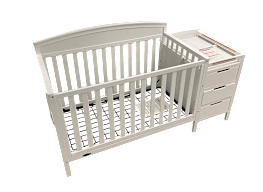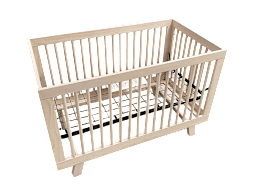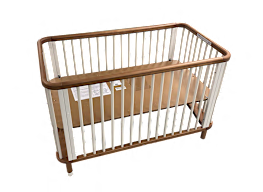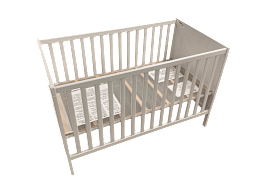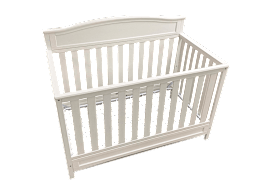Best Cribs of 2023
Consumer Reports tested nine, including convertible cribs and popular models from Pottery Barn Kids, Ikea, Delta, Nestig, and other brands
When you shop through retailer links on our site, we may earn affiliate commissions. 100% of the fees we collect are used to support our nonprofit mission. Learn more.

A crib is likely to be one of the first things you’ll purchase when you have a baby on the way. This makes it one of the most exciting—and possibly stressful—products you’ll ever buy for your kid. Thankfully, new cribs sold in the U.S. must conform to safety standards set by the Consumer Product Safety Commission, so the primary criteria should come down to budget, aesthetics, construction quality, and ease of assembly (because anyone who’s ever put together Ikea furniture knows how crucial this is).
Three Things to Look for in a New Crib
As you stroll your local department store or scroll through an online baby gear shop, there are a few things you’ll want to keep in mind.
Avoid Buying (or Borrowing) a Used Crib
If for any reason you must buy (or borrow) a used crib, make sure it’s a stationary-side crib manufactured after 2013, because federal safety standards for stationary-side cribs went into effect in 2011 (the two additional years provide a bit of safety wiggle room). Check the crib for a label that includes the model number and the manufacturing date or lot code, as well as contact info for the manufacturer. Typically, these codes appear in a discreet spot on the crib frame, or underneath the mattress support. If you can’t decipher the manufacturing date from the lot number or lot code, call the manufacturer and ask. If there’s no clear label, don’t use the crib.
“Sometimes a used crib may be passed on to you disassembled,” says Joan Muratore, test program leader at Consumer Reports. “I’d be very nervous about that because you won’t know if there’s missing hardware unless you have the assembly instructions.” The same goes for “open box” cribs that were previously bought and returned; they could be missing parts, so it’s best to avoid purchasing these. Drop-side cribs, which allow for one side of the crib to temporarily lower to provide easier access to the baby, are dangerous and have been banned since 2011. Do not use drop-side cribs.
Make Sure the Crib Isn’t too High for You and Other Primary Caregivers
Cribs that are too high off the ground make it difficult for shorter parents to comfortably access their child. “If a store has a floor model of the crib you’re considering, lean over the rail as if you’re picking a baby up from inside the crib to see whether the crib’s rail height is a good fit for your height,” Muratore says.
Check That the Mattress Fits the Crib
If the crib is too big for the mattress, the baby could become trapped and suffocate. “If you can fit more than two fingers between the crib frame and the mattress, the mattress is too small,” says Muratore. If that’s the case—time for a new mattress.
How Consumer Reports Tests Cribs
Muratore’s team took a streamlined approach to testing these cribs, focusing on three main criteria: How easy is the crib to assemble? Is it quality construction? And how easy is it to change the height of the mattress?
Ease of assembly: Is it simple to put the crib together, or is it so complicated that you might find yourself in tears before the crib’s ready to go? Muratore is pretty adept at putting things together—she’s been doing it for nearly 30 years here at Consumer Reports. She used a methodology known as the Consumer Assembly Friendliness (CAF) score. The CAF considers the total number of parts, how many actions it takes to assemble, and the number of different types of parts, to reach a total score. The fewer parts, the better for each. Assembling the crib should be straightforward enough that you would not need to hire a professional.
Construction quality: Our testers looked at the primary crib material (Hardwood? Softwood? Engineered wood? Metal?), the type of mattress support (the slats or platform that support the crib mattress), and how the support is attached to the crib itself. They also looked at the placement of the required safety label—parents may be tempted to remove obtrusively placed safety warning labels, such as those that would be visible above the sleeping baby’s head—as well as how easy the label is to remove. (Hint: Don’t remove the label!) Muratore’s team also looked at any flaws or defects in the construction of the crib, such as dents or nicks that were painted over rather than repaired, parts that didn’t fit together perfectly, or inconsistent colors.
Ease of changing mattress support height: Young infants sleep in a crib at the crib mattress’s highest support height. As the baby gets older, you lower the mattress (decreasing the likelihood that the baby will be able to lift themselves or climb out). Typically, parents need to change the crib mattress height only a handful of times, so this made up a small fraction of the total score of each crib. However, the ease of this essential task nevertheless adds to the overall experience a parent will have with their baby’s crib. We looked at how easy or difficult it was to accomplish this task, and whether it requires two adults or one.
A note on convertibility: Many of the cribs we tested are convertible, which means you can modify them into toddler beds, daybeds, and even full-sized beds. Consumer Reports refers to the convertibility listed in each crib’s manual, which may occasionally differ from what the company advertises.
Consumer Reports tested nine cribs, including the popular Babyletto, the TikTok favorite by Nestig, a budget-friendly option from Ikea, and a steel crib that (spoiler) we loved. Below, you’ll find our three most highly rated models; for more, head over to our cribs ratings.


















